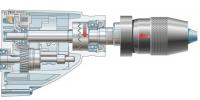How to build a balcony with your own hands
A beautiful balcony makes the architecture of a private house more interesting and attractive, sets its tone and special style. Often it becomes a real highlight, decorating the strict rectangular shape of the building. However, the purpose of the balcony is not only in the enrichment and revitalization of the facades. This structural element, of course, significantly increases the comfort of living for the inhabitants of the house and significantly improves the functionality of the premises.
The balcony increases the illumination of the room in which it is located, this is especially true in the bedrooms of the attic floors. It is an additional living space used for admiring the beautiful scenic view, organizing family tea parties, relaxing and working in the fresh air. In the southern regions, the balcony is used for sleeping in the warm season and organizing a dining room for the whole summer. Restless mothers can easily look after children walking on the street from the balcony. And of course smokers - that's who can appreciate all the amenities of owning a balcony in their room, albeit a very small one.
The balcony will serve as a good natural canopy. Under it there may be a porch of the main entrance, a terrace and just a seating area. Often the basis of the balcony is the overlap of the veranda.
Where to place the balcony, and how it should be
It is no secret that the construction of a balcony is troublesome and expensive. Therefore, when starting work, you should accurately determine how it will be used. The dimensions and shape of the balcony can be almost any, the main thing is that these parameters are in harmony with the architecture of the house.
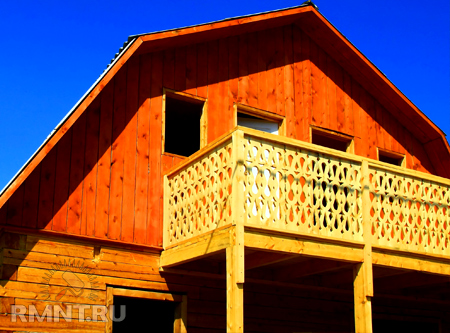
Very often, balconies are located between the corner walls of the building, which significantly increases the reliability of its attachment to the supporting structures. As a rule, they are well protected from the influence of the dominant wind and the gaze of curious neighbors. Sometimes the base of the balcony rests on the walls of the veranda and serves as its ceiling.
A balcony intended for decorative purposes may be limited to just a door and a balustrade, the so-called "French balcony". If the balcony has only an applied function (drying clothes, smoking ...), then a small extension of 700-1000 mm will be enough. But the balcony for relaxation will require a slightly larger size, because it will need to place a table, a few chairs, a sun lounger and other overall items. Such a balcony must be made at least 1500 mm wide using support posts.
The best material for building a balcony is wood. Wood has very good thermal insulation properties, therefore, the formation of cold bridges, which are so characteristic when using reinforced concrete slabs, especially pinched ones, is almost completely eliminated. Due to its low specific gravity, a wooden balcony is easy to make even after building a house, using an independent structure. Needless to say about the decorative attractiveness and functionality of wooden balconies, an example is the unsurpassed beauty of the designs characteristic of Scandinavian and Alpine houses.
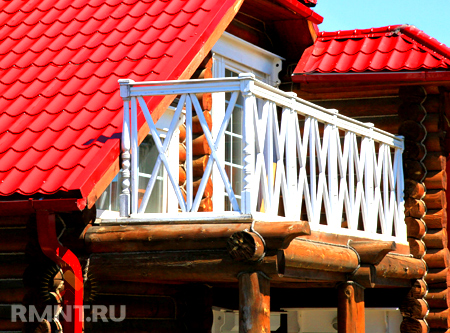
Very carefully you should approach the choice of the place where the balcony will be located. Often it is absolutely impractical on the front facade of the house, due to the fact that the views from it open only to the road or the houses of the neighbors opposite. Well, if the exit to the balcony is from a wide room, hall, then the balcony door will not occupy the precious area of the walls of the attic floor. Balconies with access from dimly lit rooms located under the roof (bedroom, office) are widely used. A door with a large glass area will significantly increase their illumination.
Frame device
If the construction of a wooden balcony is carried out during the construction of a house, it is advisable to use interfloor beams as the basis for its frame, the special length and support system for which is calculated and provided in advance.
You just need to release them beyond the plane of the wall to the distance of the expected removal of the balcony. The section is approximately 150x50-150x80 mm, which is quite enough to avoid collapse and deformation of the frame even without supporting pillars. The width of the balcony in such cases is made up to two meters.
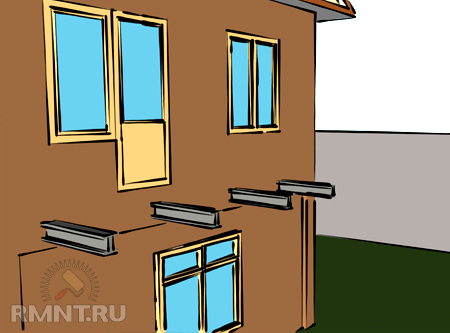
Sometimes the outrigger floor beams cannot be used to assemble the foundation. For example, if the installation of the balcony takes place after the completion of the building, or if the floors are made of reinforced concrete. Then the design of an independently standing balcony with several support posts is used.
Initially, a powerful beam with a cross section of at least 150x50 mm should be fixed to the wall using anchors or galvanized metal consoles. The method of its installation should be chosen depending on the characteristics of the main wall of the house. It is difficult to overestimate the importance of the requirements for the reliability of fastening this element.
Next to the wooden columns of the balcony, a cross beam is mounted strictly horizontally, which will serve as a support for the load-bearing beams of the balcony floor. It will be much more reliable if the transverse beam rests on the columns from above, and is not screwed to them overlay. It should be installed slightly lower than the wall support beam, so that when sewing the finishing floor, an “invisible” slope of 1-2 degrees is formed. In general, it is recommended to make the entire site below the floor level of the room somewhere within 50-100 mm, so that when the snow melts, water does not penetrate inside the house.
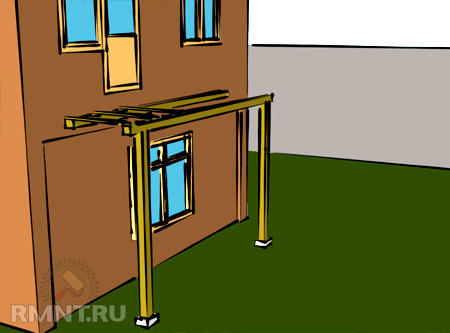
Balcony beams with a section of 150x50 mm and a pitch of 500x700 mm are installed on support bars with a pitch of about 500 mm and fastened with corner roof consoles made of galvanized metal.
The assembly of the frame should be done very carefully, since the platform from below is very clearly visible. All beams must be planed and sanded before installation in their places.
Arrangement of struts and columns
When using a beam-cantilever structure with a sufficiently large extension of the balcony, struts are used to reinforce the base. Sometimes they are made of a wooden beam cut into the extreme beams of the balcony area and abutting against the embedded elements of the main wall. Often, a wooden strut is a right-angled triangle, one of the legs of which is attached to the facade with anchors, and the other is screwed to the beams of the balcony platform.
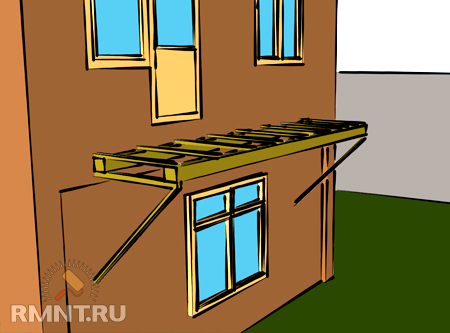
Struts made of twisted and forged metal look very nice in combination with the wooden structure of the balcony. They are durable and practical, it is much easier to securely fasten them with anchors to the load-bearing wall due to the relatively small thickness of the metal relative to the timber.
If the construction of a balcony is based on a structure with an independent wide balcony (beam-rack system), then its outer part must necessarily rely on pillars, which, as well as struts, can be more than two pieces depending on the dimensions of the product.
The installation of columns is carried out on a columnar foundation, the strength of which is subject to serious requirements. It is better if the sole for the racks is poured simultaneously with the foundation of the building and is one with it, an example is a reinforced concrete porch. This eliminates the risk of distortions and deformations due to the planting of soil or walls of a wooden house.
For the construction of wooden columns, a dry beam with a cross section of at least 100x100 mm is used. It is mounted strictly vertically, pre-fixing it with auxiliary struts made of slow-moving lumber, which can be removed after the frame is assembled. Columns are attached to the foundation using corners or special box-shaped consoles for mounting racks immured in concrete. Such fasteners are produced in various sizes so that a beam of a certain section enters the galvanized console and is securely fixed.
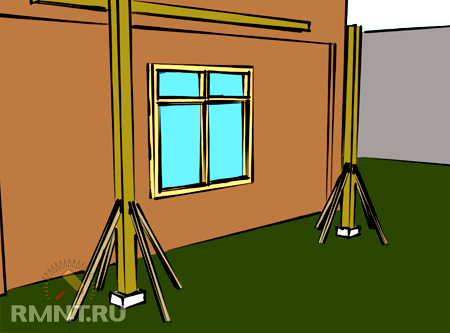
Sometimes, to ensure the strength of the rack structure, embedded inclined braces are used, which eliminate the lateral vibrations of the columns.
Making the floor
The balcony floor is made of dry planed boards with a thickness of 40 mm or more. It is fixed perpendicular to the load-bearing beams through the body, having previously made potai to hide the heads of the self-tapping screws. Between the floor boards, gaps of about 1-2 mm are left, through which atmospheric moisture can be freely removed from the balcony area. For the same purposes, the edges of the upper layers of the boards are planed to form chamfers at the joints.
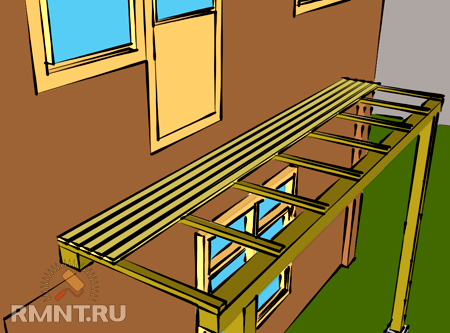
The floor of the balcony, sewn up with the so-called "decking board", will have very good performance characteristics. This relatively new material is a composite mixture of plastic and wood fiber. It, like wood, is easily drilled, cut and processed, being stronger and denser. The terrace board has a non-slip corrugated surface, tinted to look like precious woods, often with a beautiful texture. Many manufacturers complete their composite board with a system of hidden fasteners, which, of course, has a positive effect on the appearance of the finished product.
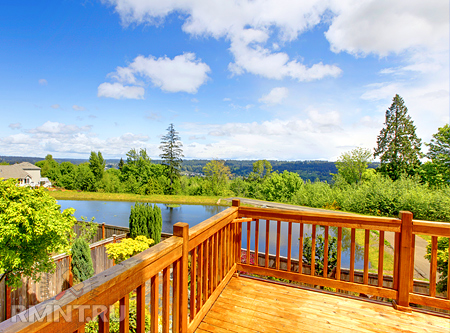
balcony railing
Railings are a very important design element of the balcony. In addition to performing a purely applied function, a beautifully made balustrade greatly decorates the appearance of the whole house. For the manufacture of railings, chiseled or carved wood is most often used, but forged metal also looks great, organically combined with both the wooden structure of the balcony and the overall architecture of almost any building.
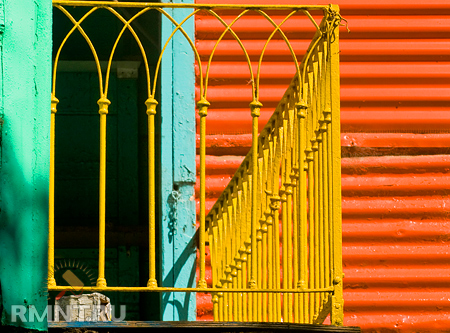
Fencing posts must be securely fastened to the supporting beams by means of spike joints or double-sided self-tapping studs. Often, various brackets, corners, metal struts are used to mount balustrade poles, including for fastening to walls.
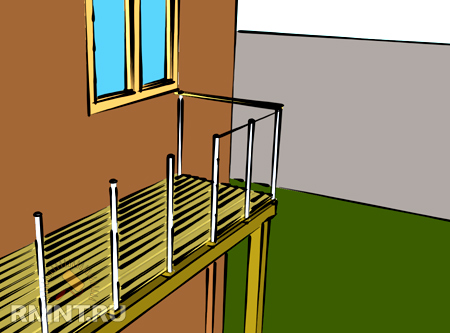
With a large length of the balcony, in addition to corner and wall racks, several intermediate ones are installed, because according to safety standards, the fence must withstand a horizontal load of 100 kg / m or more. Between them, vertical or horizontal filling is performed. If there are children among the inhabitants of the house, then the distance between the elements of the railing should be no more than 100-120 mm, and the horizontal fence should be abandoned altogether so that the children do not climb on them. Another requirement is the height of the balustrade - this is about 900-1200 mm from the finished floor.
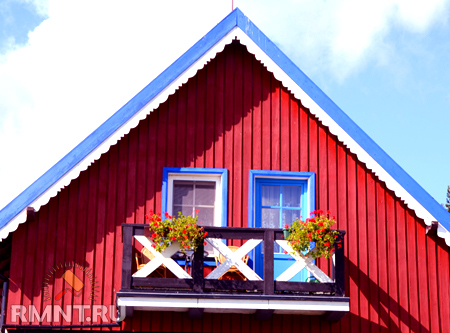
canopy
A canopy is not always made for a balcony, however, in order for outdoor recreation to be truly comfortable, it is still worth covering the site. The most logical option is to have a balcony under the common roof with the house. If the site is located on the gable wall, then the ridge line is lengthened, and additional rafters and sheathing boards are placed. If a roof overhang is located above the balcony, then the rafter legs are lengthened.
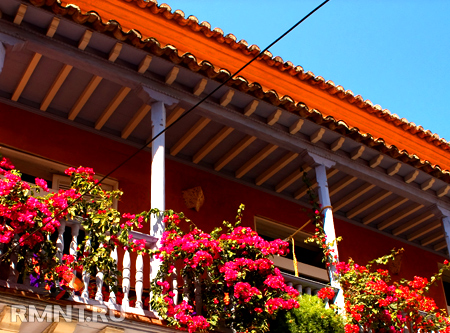
Noteworthy is the option with an independent canopy attached to the wall. In this case, a support board is fixed to the load-bearing wall, on which the rafters are laid. The front part of the canopy should rest either on struts extending from the wall, or on pillars, which can be used as supporting columns of the balcony protruding beyond the level of the site. It is preferable if the roofing material for the canopy is the same as for the roof of the house.
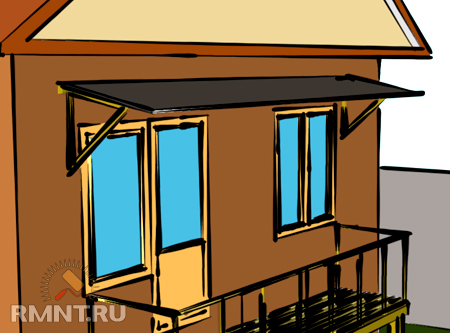
Sometimes, PVC or fabric awnings with a light frame structure are used to protect against the weather. Such canopies, professionally manufactured and installed, have an attractive appearance and a reasonable price.
Protective covering
All wooden elements of the balcony require weather protection. Only high-quality processing with specialized paints and varnishes ensures the proper durability of a wooden structure. When choosing compositions, one should take into account their resistance to sunlight, temperature fluctuations, humidity, and mechanical stress. The best for outdoor use are alkyd-urethane varnishes, which are very hard with considerable elasticity and have high weather resistance. The entire coating complex (primer, impregnation, varnish) must be from one manufacturer, which guarantees their mutual compatibility.
First of all, wood putty closes up bumps, cracks and scratches on the surface of the wood. Further, after complete drying of the putty composition, it is carefully polished and dust is removed.
To equalize the absorbency of wood, it is coated with a special primer, which helps to reduce the consumption of compounds for the subsequent stages of painting and the uniformity of applying the finishing layers.
Using tinting impregnations, you can imitate valuable wood species, highlight the texture, effectively hide stains and other surface defects.
Finishing is carried out by spraying in several layers of glossy, matte or semi-gloss coating. Sometimes it is recommended to grind each new layer of varnish, except for the last one, with a very fine abrasive - from No. 220, then the surface will be perfectly flat and smooth.
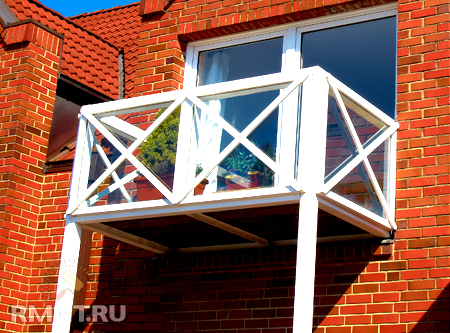
Results
Of course, the construction of a balcony will require certain financial and labor costs, the amount of which depends on its design, dimensions, and the specifics of the materials used. You should not discount the cost of annual maintenance of a remote outdoor structure and the purchase of additional necessary accessories, such as: furniture, a glazed balcony door, flower tubs, protective wind screens, awnings, sun umbrellas, a wooden perlog with climbing plants. There is some heat loss through the doors.
However, how nice it is to be able to admire nature while sitting in a comfortable chair on the balcony, have breakfast outdoors with your family, sunbathe, work or relax in the shade - and all this without leaving your home.
Of course, everyone chooses for himself, after weighing all the pros and cons, but, you see, beauty and comfort are truly priceless.
Anton Turishchev, rmnt.ru



